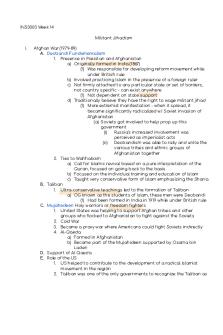Week 14 Assignment PDF

| Title | Week 14 Assignment |
|---|---|
| Course | Medical Terminology |
| Institution | Daytona State College |
| Pages | 3 |
| File Size | 52.6 KB |
| File Type | |
| Total Downloads | 8 |
| Total Views | 166 |
Summary
Answers to Assignment 14- building and defining words pertaining to sugar intake (Hyperglycemia)...
Description
Use glyc/o (sugar) to build words that mean: 1. blood condition of excessive glucose hyperglycemia 2. blood condition of deficiency of glucose hypoglycemia 3. forming or producing glycogen glycogenesis Use pancreat/o (pancreas) to build words that mean: 4. inflammation of the pancreas pancreatitis 5. destruction of the pancreas pancreatolysis 6. disease of the pancreas pancreatopathy Use thyr/o or thyroid/o (thyroid gland) to build words that mean: 7. inflammation of the thyroid gland thyroiditis 8. enlargement of the thyroid thyromegaly Build surgical words that mean 9. excision of a parathyroid gland parathyroidectomy 10. removal of the adrenal gland adrenalectomy Match the terms with the definitions in the numbered list. Acromegaly Addison disease cretinism Cushing syndrome diuresis Exophthalmic goiter glycosuria hirsutism hyperkalemia hyponatremia myxedema pheochromocytoma thyroid storm type 1 type 2 1. abnormal enlargement of the extremities acromegaly 2. hypothyroidism acquired in adulthood myxedema 3. increased excretion of urine diuresis 4. excessive growth of hair in unusual places, especially in women hirsutism 5. congenital hypothyroidism cretinism 6. crisis of uncontrolled hyperthyroidism thyroid storm
7. caused by deficiency in the secretion of adrenocortical hormones Addison disease 8. characterized by protrusion of the eyeballs, increased heart action, enlargement of the thyroid gland, weight loss, and nervousness exophthalmic goiter 9. excessive amount of potassium in the blood hyperkalemia 10. small chromaffin cell tumor usually located in the adrenal medulla pheochromocytoma 11. insulin-dependent diabetes mellitus; occurs most commonly in children and adolescents (juvenile onset) Type 1 12. decreased concentration of sodium in the blood hypocalcemia 13. abnormal presence of glucose in the urine hyperkalemia 14. metabolic disorder caused by hypersecretion of the adrenal cortex resulting in excessive production of glucocorticoids, mainly cortisol Cushing syndrome 15. noninsulin-dependent diabetes mellitus; occurs later in life (maturity onset) Type 2 Match the terms with the definitions in the numbered list. antithyroids corticosteroids exophthalmometry FBS GTT insulin oral antidiabetics RAIU T3 T4 TFT total calcium test transsphenoidal
growth hormone thyroid scan
1. measures circulating glucose level after a 12-hour fast FBS 2. detects how quickly ingested iodine is taken into the thyroid gland RAIU 3. replacement hormones for adrenal insufficiency (Addison disease) corticosteroids 4. increases skeletal growth in children growth hormone 5. nuclear imaging procedure that shows the size and shape of the thyroid gland thyroid scan 6. thyroxine T4 7. used to treat type 2 diabetes oral antibiotics 8. test to determine how quickly glucose is cleared from the blood GTT
9. used to treat hyperthyroidism by impeding the formation of T3 and T4 hormone antithyroids 10. type of hypophysectomy to remove a pituitary tumor without disturbing brain tissue transsphenoidal 11. triiodothyronine T3 12. abbreviation for a test that measures thyroid function TFT 13. test that measures the degree of forward displacement of the eyeball as seen in Graves disease exophthalmometry 14. used to detect bone and parathyroid disorders total calcium test 15. hormone used to treat type 1 diabetes insulin
1. How long has this patient been experiencing voracious eating? The patient has been experiencing voracious eating for the past 10 days 2. Was the patient’s obesity a result of overeating or a metabolic imbalance? The patient’s obesity was a result of overeating 3. Why did the doctor experience difficulty in examining the patient’s abdomen? The doctor experienced difficulty in examining the patient’s abdomen because she was obese 4. Was the patient’s blood glucose above or below normal on admission? The patient’s blood glucose was above normal on admission 5. What is the reference range for fasting blood glucose? The reference range for fasting blood glucose is 70-110 mg/dL...
Similar Free PDFs

Week 14 Assignment
- 3 Pages

Homework Assignment 14-Chapter 14
- 13 Pages

Week 14 Lab Worksheet
- 2 Pages

Week 14 GST - GST
- 4 Pages

Disease Processes Week 14
- 6 Pages

Week 14 Notes
- 9 Pages

TASK WEEK 14
- 3 Pages

INS3003 Week 14 Notes
- 5 Pages

Zoo biology week 14
- 5 Pages

Week 14 Reading Response
- 1 Pages

Week 14 Lab Worksheet
- 2 Pages

Chapter 14 Assignment
- 2 Pages

Chapter 14 Marketing Assignment
- 4 Pages

HIM220 Assignment Chap 14
- 11 Pages

Week 6 Assignment - Week 6
- 11 Pages

Ch 14 Key - Assignment
- 14 Pages
Popular Institutions
- Tinajero National High School - Annex
- Politeknik Caltex Riau
- Yokohama City University
- SGT University
- University of Al-Qadisiyah
- Divine Word College of Vigan
- Techniek College Rotterdam
- Universidade de Santiago
- Universiti Teknologi MARA Cawangan Johor Kampus Pasir Gudang
- Poltekkes Kemenkes Yogyakarta
- Baguio City National High School
- Colegio san marcos
- preparatoria uno
- Centro de Bachillerato Tecnológico Industrial y de Servicios No. 107
- Dalian Maritime University
- Quang Trung Secondary School
- Colegio Tecnológico en Informática
- Corporación Regional de Educación Superior
- Grupo CEDVA
- Dar Al Uloom University
- Centro de Estudios Preuniversitarios de la Universidad Nacional de Ingeniería
- 上智大学
- Aakash International School, Nuna Majara
- San Felipe Neri Catholic School
- Kang Chiao International School - New Taipei City
- Misamis Occidental National High School
- Institución Educativa Escuela Normal Juan Ladrilleros
- Kolehiyo ng Pantukan
- Batanes State College
- Instituto Continental
- Sekolah Menengah Kejuruan Kesehatan Kaltara (Tarakan)
- Colegio de La Inmaculada Concepcion - Cebu